Sixguns
- Login to post comments
the following is the link to the entire Sixguns, by Elmer Keith. I just found it on the net.
http://www.sixgunsbykeith.com/toc.asp
It does not want to open. Says you have to be a member, but will not allow new members. I hope some one was not charging money for memberships, to read Elmer's book.
This is the link for Milt Sparks 200 holster that Elmer helped to design. The perfect holster for the 44 Mag. This with the Keith Knife, should be Standard Operating Procedure for any serious person with a handgun for hunting, or serious personal protection. The finest is not cheap, but always worth it.
I am going to put one on my Christmas List this year.
http://www.miltsparks.com/200AW.htm
Priced at $115.00 is not high at all. About normal if you ask me!
![]()
![]()
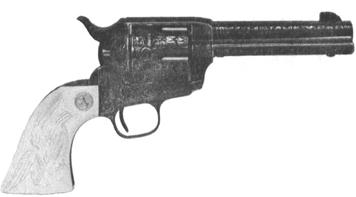
Single Action Colt with elaborate engraving by R. J. Kornbrath.
FOR OVER THIRTY YEARS I wore a sixgun as regularly as I did my trousers. Without it I did not feel fully dressed. It was a tool, and a mighty useful one at that. I still like to have a good gun in easy reach at all times.
During those years I tried out, on both stock and game, every make and caliber available – everything from the 36 Navy Colt, 44 caliber Dragoon, and Single Action Army Colt down through modern revolvers and semi-automatics. During that time I killed three elk, seven mule deer, one whitetail, three black bear, one record cougar, and one mountain goat with a sixgun, not to mention coyotes, bobcats, eagles, and a Mexican javelina.
Over the years the small game ran into the thousands, but the only record kept was on blue grouse when I killed from 41 to 43 of the big birds for three successive years with a sixgun. I remember killing 125 jack rabbits on the Pahsimeroi in three days when testing one of the first 357 S & W Magnums. In over twenty years of big-game guiding, I also trailed and finished with a sixgun many animals of all species that my parties had wounded.
On two occasions I had to stop mad cows I had roped. They wound me up and threw my bronc and came for me with sharp horns. On another occasion I had to get out of bed, saddle up a bronc, and go to the rescue of a local butcher who had tried to kill a big Durham ball with a Colt by planting the slugs in the forehead. The beast had put the butcher up a tree and, as it was cold weather, he was fast freezing when the neighbor called. When I rode up close to the tree, the bull charged. A single 265 grain 45-cal. Ideal slug, backed by 40 grains of black powder, in the forehead from my old 5 1/2″ Single Action Colt did the trick. The bull stuck his nose in the ground and turned over on his back with all four legs stiff in the air, his tail stretched out toward my bronc, then he relaxed in death.
On another occasion, a mean outlaw bronc I was riding stuck his foot in a badger hole and turned somersault over me. He knocked most of the wind from me and came up running, kicking me with his hooks because one spur had caught around the stirrup leather and held my boot in the stirrup during the roll. Three 45 colt slugs angling upwards from where I bounced along the frozen ground did the trick. The third one reached the spine and put his hind quarters down, and I simply planted the fourth in his brain – and had a long hike home packing heavy saddle. But for that Colt Single Action, I would have been dragged and kicked into doll rags.
On one trip out to Ovando, my sixgun kept my partner and me in meager food supply for six days while we traveled with a pack string of twenty-three horses. The grub horse had busted a yellow-jackets’ nest and bucked off down the mountain and across a river. When we found her, there was no food left in the pack. We lived by that sixgun alone for those six days.
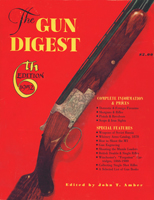
To read other articles from Gun Digest 1952, and get online access to all 65 years of Gun Digest book content, visit Gun Digest Research.
Far more often the sixgun was needed to kill a rattler, collect a mess of grouse or sage hens, or rabbit for the cow dogs’ dinner. Whether I had to climb out of the blanket to kill a porcupine that was eating the pack outfit, or clean the pack rats out of some cabin wished to sleep in during a rainy night, or simply heave a slug in front of a band of running horses to burn them toward the corral, the old sixgun was always hear and handy. It was a tool of the trade.
On other occasion the old gun was packed for social purposes – when serving on sheriff’s posses, hunting cow thieves, or to back our honor and judgment. I still remember seeing one cow thief squirm when I watched him and his three riders while my partner cut four of my steers from two cars of beef that he was preparing to load on the train. Those steers had my brand, badly blotched, and the wattle cut off their noses, but I would have known their hides in a tan yard; so I took them by force. Suffice to say, I would have been pushing up daisies over twenty years ago instead of writing this article now, had I not carried and known how to use a good, heavy sixgun.
Guns were usually carried in a shoulder holster or, more often, in an open-top, quick-draw belt holster that left both hammer and trigger fully exposed. The bottom of the belt holster was tied to the leg or to the chaps so that the gun would not fly up and hit the elbow when riding a pitching bronc. Holsters were just large enough to accommodate the gun, and the belts were more often than not a combination of money and cartridge belts of double-soft chap leather. We never did see any of those huge buscadero Hollywood corsets in use on the range, nor did any of the old gun fighters I knew in my younger days use such an outfit.
Helena, Mont., was settled in the late sixties, largely by Confederate Civil War veterans. I knew, lived, and hunted with several of these men, most of whom owned or carried a good sixgun, either an old cap and ball Colt or a more modern single action. Now they are all dead and gone, and the modern trend seems more to small-caliber target guns. Colt has even stopped manufacture of the best gun they ever built – the Single Action Army.
I witnessed three gun fights when a kid in Helena and was not much impressed by the results from the 38 Special. In one, one man proved the quicker on the draw and a couple of 38 Specials through the heart stopped his opponent even though the opponent did draw and fire two shots that hit the pavement short of his executioner. In another, a cop planted five 38 Specials in a gunman’s chest, about center, yet that gunman emptied his break-top 32 at the cop. One bullet, I thought the first, hit the cop right over the heart but went through a notebook and lodged in the bottom of his blouse pocket. One more went through a kid’s leg as he was peacefully engaged in eating noodles in his booth, and the rest came through the front window over my head and flattened against a building across the street.
The gunman then threw his gun at the cop, and it also went through the window and across the street. He died as he was carried up the hospital steps. Another time my friend Bill O’Connel, the night cop around the N.P. Depot, killed two holdup men who had stuck up a saloon, with one shot each from his 45 Colt Single Action. Their one return shot only went through a transom window over Bill’s head as he entered the saloon. Read Part 2 →
Sixguns – Part 2
Categories:: Gun Articles • Gun Digest Classics • Handguns
Elmer Keith | Aug 18, 2009 | Comments 0

 Add to favorites
Add to favorites

![]()
![]()
![]()
![]()
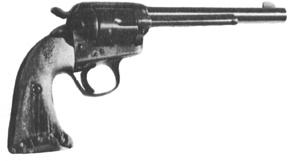
Shown is a Colt Bisley model with horn grips.
Small-Caliber Pistols
The 22-caliber sixguns and semi-auto pistols are useful for just one thing – target practice and competition. They may also be used effectively on very small game with high-speed hollow points occasionally. The 32-20 and 38 Special factory loads are far better small-game loads as a whole, but both lack power for any serious social purposes, for shooting game of any size, or for use against mean stock.
I have killed three mule deer with the 32-20 low-velocity smokeless soft-point load, and the cartridge proved entirely inadequate. I have also killed a couple of muleys with a K-22 S & W at close range, working on the backs of their heads double action. I had walked out on the edge of a small cliff and a big buck and a doe appeared just under me at about six yards range. A quick shot, double action, to the back of each head put both of them down, but each got up on its feet almost instantly. Two more shots were taken at each, and then the gun was empty. Both were down and kicking, but I had hardly reloaded when both were up again.
Then I started shooting at the back of the neck, just to the rear of the skull. When the gun was again empty, both were dead, but I will never try that stunt again. Another time, I had put two 172-grain 30-06 slugs in a big mule buck and he went down. Not wanting to shoot him up any more, I borrowed Jim Robbin’s Colt Woodsman and proceeded to empty the gun in him. I hit the deer between the eyes with the first shot and heard the tiny slug whine as it ricocheted away. As the buck ran past, I put the rest of the magazine in close behind the shoulder. The buck went a couple hundred yards and again lay down. I approached to within 30 yards as he lay in the sagebrush watching me. I bounced most of another magazine off his skull before one bullet went through the tiny nerve hole over the left eye and killed him. No more 22′s for me on anything bigger than bullfrogs, squirrels, or cottontails.
Contrary to popular opinion, the 32-20, 38-40, and 44-40 factory soft-point low-velocity loads will expand very well on deer and, if bones are struck, turn wrong side out. Yet the bullets will not expand in pine wood, simply smearing off the soft point and leaving the jacket intact. I wore out completely one 32-20 barrel with both factory loads and handloads in game shooting. I have also shot a 38-40 and a 44-40 a great deal. All three cartridges are bottlenecked and the chambers are much too long for the body of the case. When fired, the cases expand nearly to the mouth, leaving only about half of the original neck and requiring considerable resizing to reload them. I used to use No. 80 powder and the 260-grain 40-82 Winchester bullet sized down to fit in the 38-40.
The combination was superbly accurate from a 5 1/2-inch Single Action Colt, and a real killer on anything, but constant resizing made for short case life and I finally gave it up. The 44-40 is by far the best of these three rifle cartridges, and it was old-timer Ashley Haines’ favorite sixgun load, but the 44-40 does its best work from a long 7 1/2-inch barrel owing to being loaded with rifle powder. I never could get much penetration with factory 38-40 or 44-40 loads from a sixgun, and soon came to prefer longer, heavier bullets that would give better penetration on stock or big game when the necessity for such use arose. A factory 38-40 load almost cost me my life while monkeying with a wounded bull elk. The bullet simply splattered on the elk’s skull, and did not penetrate. Had the cylinder not been loaded alternately with heavy black powder loads, that bull would have ended my hunting. With both cartridges, the case body is large and the neck short for short bullets. The charge must be held down religiously to safe pressures or it will bulge the bolt cuts in the cylinder.
My Preferences
The Gun Digest 3-DVD Set contains all 65 editions from 1944-2009 in PDF format.
I much prefer the 44 Special and the 45 Colt cartridges for sixgun use. For the handloader, the 44 Special is by far the best of all sixgun cartridges for serious work, either target, defense, or game killing. The cylinder walls are thicker over the case body than in the 45, and the cartridge is superbly accurate. The old black powder loads with 250-, 255-, and 260-grain government bullets and 40 grains of FFG black powder gave 900 feet in the 45 Colt and would surely penetrate. I planted a 250-grain Remington black powder load in the seat of a goat’s pants and it penetrated through to the left shoulder, which it broke. On broadside shots on both elk and goats, it went clean through unless heavy shoulder bones were hit. The 38-40 and 44-40 factory loads stopped under the skin on the off side on lung shots on elk. With the heavy 260-grain 38-40 handload, penetration was excellent.
Another 45 Colt load that gave excellent accuracy and penetration was the Winchester 300-grain 45-90 lead bullet sized down to .454 inch and backed by 35 grain of FFG. It killed mule deer and wounded elk well and was very accurate. I once had a case head separate with this load, blowing the loading gate out of the gun and cutting through the side of my trigger finger. That case had been reloaded many times, however, and the load was safe enough in good cases.
The factory 45 Colt pointed bullet punched a rather small hole through game and would not expand unless it hit a heavy bone. With that bullet I shot a great many grouse with little damage to the meat. In search of the best sixgun bullet, I designed a blunt-nosed bullet (No. 454260) for Belding & Mull but found that it or the same design worked out for the 44 Special in 260- and 280-grain was not accurate at any great range, so we dropped them and designed another bullet for Lyman. First in 44 Special, 250-grain solid and 235-grain hollow base or hollow point, then in 45 Colt 250-grain, later in 45 semi-auto rim 240-grain, and still later in 173-grain solid and 160-grain hollow base or hollow point 38 Special, these Keith bullets have proven ideal, for me at least, for all sixgun work in twenty years of continuous use. They cut full caliber holes in anything and penetrate almost as well as the old pointed 45 Colt black powder load in solid persuasion. In hollow-point design, they will expand at velocities of 1,000 feet or more, and at 1,200 feet are very destructive to all game and ruinous to small game.
The Keith 160-grain 38 Special hollow point, backed by 13.5 grains of 2400, from the Colt Single Action or Shooting Master, or the S & W Heavy Duty or Outdoorsman will simply blow a grouse to bits and wings. The legs and neck will fly off at all angles when the bird is centered. The Keith 235-grain 44 Special hollow point, backed by 18.5 grains of 2400, is even worse in its destruction of living tissue. It’s certain death on either elk or deer if placed in the lungs broadside at close range, but it will not penetrate quite as well as the 250-grain solid in bone or when meaty portions of an animal are struck. Bob Hagel killed eight treed cougar last winter with a 44 Special 4 1/2-inch barrel Single Action Colt using these loads. He said the hollow point was much the best for a chest or lung shot and the solid bullet best for shoulder shots to break the big cats down so that they would not fall out of the tree full of fight.
I have tried both the Super 38′s and the 9 mm Lugers on game, also the 45 semi-auto, for many years and they are one and all far inferior in actual knockdown power to the heavy revolver loads. A friend emptied a Super 38 Colt into a cougar’s chest at close range in a tree, but the big cat jumped out and ran a short distance. One heavy 44 Special or 357 Magnum or 45 Colt in the same place would have done the business. Metal-patched bullets from the semi-auto pistols are simply not as good stoppers as are the soft lead bullets of the revolver, but the 45 Colt semi-auto has more actual shock on game than either the Luger or the Super 38. I have shot enough game with all three to prove the point, to my own satisfaction at least. Read Part 3 →
![]()
![]()
![]()
![]()
![]()
Sixguns – Part 3
Categories:: Gun Articles • Gun Digest Classics • Handguns
Elmer Keith | Aug 18, 2009 | Comments 0

 Add to favorites
Add to favorites

![]()
![]()
![]()
![]()
This is the new 1950 S & W 45 Army revolver, the 1917 Army model brought up to date with shortened action, redesigned hammer, and new safety hammer block.
Sixguns for Self Defense
For a defense gun against man, the 1917 S & W semi-auto rim is a fine, fast gun, and one can carry a couple of the three-shot clips loaded with 45 auto ammo, preferably of the new Remington and Peters 185-grain wadcutter type, and have a very quick reload.
The late Frank Waterman carried a nickel-plated 7 1/2-inch Single Action Colt 45 all his life. His dad had given it to him new when Frank was a kid in Wyoming. Frank was past seventy when he died last year. That old Peacemaker had killed all species of game in Wyoming, Montana, and Idaho except buffalo. When on a Wyoming elk hunt, a sportsman had downed a big bull elk and the guide borrowed Frank’s 45 Colt to go back and pack out the elk as he did not want to bother with a rifle that day. They were working up a brushy creek bed to the kill, and the sportsman was some one hundred yards to the rear as usual, when the guide turned around a big willow bush and found the elk. A big grizzly was eating on the carcass. The bear instantly rose to its full height, and the guide drew Frank’s old Peacemaker. Aiming just under the chin of the big grizzly, he squeezed the trigger. The heavy 260-grain bullet backed by Frank’s 40-grain black powder load went in under the chin and broke the grizzly’s neck, and the bear went down like a sack of beans.

Read more from the 65-year archive at Gun Digest Research.
I once loaded some 44 Specials with the Keith 250-grain solid and 12 grains of No. 80 for Charley Stauffenberg. He carried a New Service Colt for that cartridge. One fall, when in need of his winter’s meat, Charley ran onto a bull moose standing broadside. Holding his gun with both hands, he aimed for the heart and shot once. The bull lurched away but went only one hundred yards and lay down and was soon ready for the knife. The flat-point Keith bullet went through the middle of the heart and bled him out nicely.
Some nineteen years ago I loaded a large quantity of the very same load for James T. Maxwell, of Omaha, Neb., for use in Africa in a 6 1/2 inch S & W. Maxwell later reported that he had no trouble at all supplying twelve men with all the antelope meat they could eat by using that gun and load alone. He said it killed the small and medium antelope about as well as a rifle during a six-week period of African hunting in Kenya and Tanganyika. Recently I had another letter from the good doctor saying he had just tested some of these same loads after all these years and they still shot as well as ever.
With the advent of Hercules 2400 powder I dropped the use of No. 80 entirely, as 2400 proved a much better propellant, giving far less pressure than No. 80 and even higher velocity.
.
Throughout the West and North, many men – prospectors, surveyors, cowpunchers, trappers, and woods’ loafers – who must make long trips into the back country, often by back pack only, and who cannot carry a rifle handily, need a good dependable heavy sixgun. The best guns for the purpose today are the Colt Single Action and the S & W 357 Magnum and 1926 44 Special target models. [1] The guns should have accurate target sights which suit individual preference as to width of blade or bead and general type, but the sights should be adjustable so that they may be correctly zeroed for any desired load. If the Colt Single Action is preferred, then it should be target sighted by King Gunsight Co., Pachmayr, or some other reliable gunsmith. The best rear sight is the S & W click adjustment target rear, with a suitable band or ramp front sight base and blade sight. The S & W target guns, both the Magnums and the 1926, come equipped with perfect sights, and front beads or blades to suit individual preference can be had to order.
For loads, I believe the 357′s & W Magnum and 45 Colt to be the best in factory loads, and the 44-40 is not so far behind, some shooters preferring it to the others. If the shooter is also a handloader, or wishes to purchase heavy handloads from Moody’s Custom Loads, Helena, Mont., or another custom loader, the best caliber is the 44 Special. The factory 44 Special makes a fine grouse and small-game load and is also an ideal target load. The Keith 250-grain solid bullet or the 235-grain hollow base or hollow point can be loaded with 18.5 grains of Hercules 2400 and bullets sized to .001 inch larger than groove diameter and cast 1 part tin to 16 parts lead for solids, and 1 to 20 for hollow points, and you have the most powerful handgun loads in existence.
The factory 357 Magnum is very good but it is not nearly as good a killer as the above-mentioned 44 Special hand-loads. Col. Doug Wesson killed elk, antelope, moose, and grizzly with the 357 Magnum, but the fact remains that the heavy Keith 44 Special loads are a lot more powerful. The factory 38 Special can also be used in the Magnum as a grouse or small-game load; wadcutters in full charge are particularly good small-game loads.
If you want to reload for the Magnum, use 13.5 grains of 2400 behind the Keith 173-grain solid bullet or the 160-grain Keith hollow point in 38 Special cases. For the longer Magnum case, use 14 grains of 2400 with the 160-grain hollow point or 13.5 grains with the 173-grain Keith solid and barely crimp the case over the front band of the bullet. The fact remains, however, that the 38 Special case, with Keith bullet and 13.5 grains of 2400, is a more accurate load at any range, even to 600 yards, than is the factory 357 Magnum or the Keith bullet from the Magnum case when the case is crimped over the forward band. Bullets should be of same temper as above for the 44 Special and should be sized to not over .001 inch above groove diameter.
In the 45 Colt, the standard factory smokeless load is a good one though at only about 800 feet velocity. It is accurate and will penetrate well. The old Remington 40-grain black powder load was much more powerful, and handloads can be made up with the Keith 250-grain Ideal bullet and 18 to 20 grains of Hercules 2400, always keeping bullets sized to not over .001 inch above groove diameter and crimping in the beveled crimp groove. In the 45 Colt, we have much thinner cylinder walls than in the 44 Special and for that reason the 44 Special has a much greater margin of safety.
The bullet, being the same weight as for the 45, also has more sectional density and will penetrate better, so for the handloader the 44 Special is absolutely tops. The factory 44 Special 146-grain bullet is loaded to only 750 feet velocity, and both the 357 Magnum and the 45 Colt, as well as the 44-40, beat it badly for killing power in factory loads. But carefully handloaded, the 44 Special comes to life. For all social purposes, when a gun is needed in self defense against man targets, the 357 Magnum is the smallest cartridge I would consider. The heavy Keith hand-loads described above are, however, much better stoppers, and a man hit anywhere between the top of the skull and the pelvic bone with one of them in 44 Special or 45 Colt will not shoot back.
Automatics are totally dependent on perfect ammunition for certain functioning and are, for that reason, a second choice for a defense gun. If a jam or a misfire occurs, then two hands are needed to clear the jam and get the gun in action again. For that reason, they are never as reliable as a good cylinder gun when one’s life is at stake.
![]()
![]()
![]()
![]()
![]()


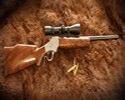
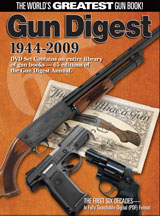
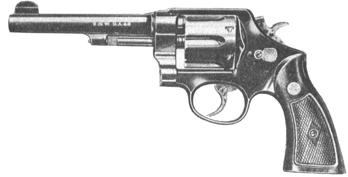
Recent comments
2 years 26 weeks ago
4 years 1 week ago
4 years 6 weeks ago
4 years 43 weeks ago
5 years 33 weeks ago
5 years 34 weeks ago
5 years 35 weeks ago
5 years 36 weeks ago
5 years 36 weeks ago
5 years 36 weeks ago